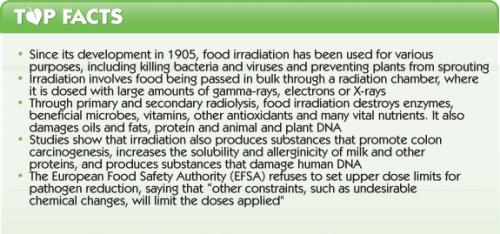Do you know if your food is irradiated, and if it were, would you be concerned? Do you know what irradiation does to your food, and do you think it is safe? Read on for the ANH lowdown on this high risk and damaging technology, that is being touted as the solution to food safety issues that plague the global food trade. The technology is overseen by the controversial, inter-governmental, United Nations-hosted body that sets global standards, guidelines and recommendations for the food trade — Codex Alimentarius.

Developed in the new atomic age of the 1950s
It’s a little known fact that ionising radiation was used to kill bacteria in food as early as 1905, and that the technology was extensively researched by the US Army for nearly 3 decades, after the detonation of the first atomic bombs in 1945. The Russians too were irradiating meat and produce in 1959. The US program was handed over to the US Department of Agriculture (USDA) in 1980. In 1985, the US Food Drug Administration (FDA) approved its use to destroy parasites in pork and, since then, its use has grown and spread.
Today ionising radiation is approved for use on food in 55 countries, with China and Brazil now being the largest users of this drastic, life-destroying technology. Irradiated beef patties are available today in every US state. The Minnesota Beef Council quotes current figures of 8000 MT (15-18,000,000 pounds) of ground beef irradiated annually in the USA, and 30,000,000 pounds of produce.
Irradiated food must be labelled as such. The green, international Radura logo is typically used, which resembles a plant within a part-broken circle. The words ‘irradiated' or 'treated with ionising radiation' must also appear on the packaging or on a display notice. These words should appear next to an irradiated ingredient in an ingredients list.

The Radura logo – the symbol that tells health-conscious consumers to avoid the food because it is irradiated
How is food irradiated?
Typically, food irradiation involves food being passed in bulk, by means of a conveyor belt, through a radiation chamber. In the chamber, the food is dosed with large amounts of gamma-rays, electrons or X-rays. The food does not actually come into contact with radioactive materials, but passes through a strong beam of radiation. Cobalt-60, a radioactive isotope of cobalt, is commonly used. The US Environmental Protection Agency (EPA) informs us that Caesium-137 is also used, and that the US Army has used spent fuel rods. The radiation doses used to process food can be as high as 10,000 gray. Putting this in to some kind of perspective, X-ray scanners usually operate at less than 0.5 gray. In the US, food irradiation facilities are regulated by the Nuclear Regulatory Commission (NRC).
In the European Union (EU), Member States must report various details about food radiation and facilities to the EU Commission, which publishes these annually in a public document. This presents interesting data about which foods are irradiated, and where, across Europe. Belgium, Germany, France and the Netherlands are presently the EU Member States than most favour food irradiation, and frogs’ legs, poultry and dried herbs are the foods most often irradiated.
EFSA says damaged food is ‘not cause for concern’
Last week we explained why chemical extraction and processing of vegetable oils is bad for your health. But high dose radiation wreaks further havoc on organic matter, chemically transforming it by primary and secondary radiolysis effects (radiolysis means chemical decomposition by radiation). The European Food Safety Authority (EFSA) argues that the effects are similar to those resulting from the chemical and heat effects of food processing, implying that it must be as safe as processed food— but the evidence and the chronic disease burden in the West strongly suggests that processed food is actually very unsafe, and irradiated food is likely to be no less so.

Irradiation would destroy the beneficial bacteria present in fermented foods such as sauerkraut, which are very important to health
Dosing food with irradiation does of course destroy valuable food enzymes, beneficial microbes, vitamins, other antioxidants and many heat or temperature-sensitive plant and animal derived nutrients. It also damages oils and fats, protein and animal and plant DNA. Studies have shown that irradiation produces radiolytic derivatives of triglycerides which promote colon carcinogenesis; that it increases the solubility and allerginicity of milk and other proteins, results in the formation of cholesterol oxides, and induces formation of furans, hydrocarbons, 2-alkylcyclobutanones, and sulfur volatiles, which have been shown to damage human DNA. EFSA acknowledges that leukoencephalomyelopathy in cats is also linked to irradiated feed ingestion, and add that the relevance of this to human health should be clarified.
While some might argue that the jury is still out in terms of the availability of convincing scientific evidence on the long-term safety of irradiation, the drastic alteration of food from its nutritious natural state says it all for us. EFSA, meantime, lamely states “considering that only a very limited quantity of food is irradiated in Europe currently…there is not an immediate cause for concern”. This is of course not the endorsement of safety that it is believed to be by some.
EFSA: Its fine to turn up the radiation dose as long as the food still looks and tastes like food!
More shocking still is that EFSA, in its Statement summarising the Conclusions and Recommendations from the Opinions on the Safety of Irradiation of Food adopted by the BIOHAZ and CEF Panels, will not specify a radiation upper dose limit for pathogen reduction. It confidently proclaims, instead, that “other constraints, such as undesirable chemical changes, will limit the doses applied"! Colour changes and offensive odours are two common 'side effects' of food irradiation. As with GMOs, it seems that the technology is acceptable as long as food still appears the same on the outside!
It won’t have occurred to them that the irradiation of herbs, whilst being ‘minor’, non-staple food ingredients, could be a major cause for concern. Wholesome, fresh or air dried, unadulterated herbs have long provided a very important source of phytonutrients in our diets, many of which have effects in reducing our risk of chronic diseases.

Many dried herbs are irradiated
European citizens need reminding how EFSA’s cavalier approach to the safety of GMOs and food irradiation stands in such stark contrast to its overly-cautious and restrictive views on safe and beneficial natural ingredients.
Downplaying irradiation to ‘cold pasteurization’
The implications for increased trade and more profits from this ‘effective’ but very damaging food safety technology are huge. The problem is— food irradiation sounds somewhat negative and un-appetising to consumers. The big boys in the food and agriculture industry prefer the process to be seen as routine, like milk pasteurisation (itself increasingly controversial). So legislation was planned which allowed the word ‘pasteurization’ or ‘cold pasteurization’ instead.
Those in favour / not in favour of food irradiation
Food irradiation technology is endorsed by the World Health Organization (WHO), the United Nations Food and Agriculture Organization (FAO), the European Community Scientific Committee for Food, the United States Food and Drug Administration, a UK House of Lords committee, and even the American Dietetic Association.
Those opposed to the technology include the Organic Consumers Association, Mercola.com, and the International Institute of Concern for Public Health, Food Irradiation Watch — and of course Alliance for Natural Health International.






Comments
your voice counts
14 December 2012 at 5:29 pm
In the US, aren't almonds irratiated? And, isn't it illegal to label almonds Not Irradiated? As a result I will only buy almonds from Spain or Italy. John
22 March 2014 at 10:36 am
Hi John, But here in Spain where I live they sell California Almonds at Mecadona and Carrefour. I would check your information if I were you. My family and I pick our own wild almonds from nearby trees as well as other wild fruits.
But more to the point, my feeling is that a species of non-human aliens have taken over our governments and have an anti-human agenda. There was no surprise to learn that the U.N. was all for food irradiation. Have they ever done anything for the benefit of the human race?
18 May 2014 at 3:49 am
Irradiated food labelling in Australia and New Zealand is under threat. Please help by adding your name to a petition calling for labelling to be retained:
http://www.chn.ge/1f5wMnf
The petition will be running until late 2015.
Your voice counts
We welcome your comments and are very interested in your point of view, but we ask that you keep them relevant to the article, that they be civil and without commercial links. All comments are moderated prior to being published. We reserve the right to edit or not publish comments that we consider abusive or offensive.
There is extra content here from a third party provider. You will be unable to see this content unless you agree to allow Content Cookies. Cookie Preferences